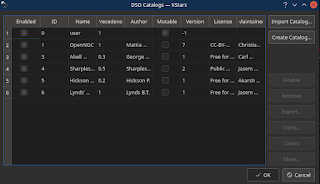KStars v3.5.5 is released on September 16th for Windows, MacOS, and Linux. This release includes a number of new features and bug fixes.
Google Summer of Code 2021
Port Selector Tool
When creating a new Ekos Equipment profile, you will be presented with the Port Selector tool if any of your devices is a serial or networked device.Your equipment profile may contain one or more serial and/or network-enabled devices. Although INDI performs an auto-search when you connect to your serial devices, it's recommended to select the appropriate ports and baud rates before connecting for the first time.
Re-usable Widgets
 Wolfgang Reissenberger implemented new reusable widgets to be used across Ekos. These widgets replace the legacy raster-based pixmaps that were used in the Summary screen to report progress in focus, capture, and guide modules. Not only this reduces the memory footprint of KStars, but it also present fully interactive widgets at native resolution.
Wolfgang Reissenberger implemented new reusable widgets to be used across Ekos. These widgets replace the legacy raster-based pixmaps that were used in the Summary screen to report progress in focus, capture, and guide modules. Not only this reduces the memory footprint of KStars, but it also present fully interactive widgets at native resolution. Scheduler Artificial Horizon Restriction
Users may define an artificial horizon zones where visibility is obstructed by natural or man-made structures. Furthermore, a terrain map can be superimposed to provide a 360 degree view of the horizon.
Artificial Horizon constraints, when enabled via the standard artificial horizon UI, will now be used by the scheduler to start or interrupt jobs. That is, if there is an artificial horizon constraint at a given azimuth, it will be used by the scheduler, along with the standard altitude constraint to determine if a job can start or continue. The scheduler uses the max of the altitude constraints as the constraint to enforce.
Ekos Internal Guider Improvements
- Dither options used to be in GOM's Guider Tab. Now the GOM has a Dither tab for dither parameters.
- Moved the control parameters (e.g. DEC proportional gain = 133) to the GOM's Guide tab (where dither parameters used to be).
- Removed the Control sub-tab from the Guide page (the sub-tab next to "Drift Plot" and "Calibration Plot").
- Removed UI controls related to image guiding and rapid guiding
proportionalResponse = arcsecDrift * proportionalGain * arcsecPerMsPulseUsers are highly recommended to revise their internal guider settings to achieve the best results.
More Improvements & Fixes
- Add shortcuts for increasing and decreasing the time scale (by Nate Graham).
- Control Mount with arrow keys (by Siyu Zhang)
- Eliminating formerly required Python options for local astrometry.net on MacOS (By Robert Lancaster)
- Stable alphabetical INDI device order (by Dušan Poizl)
- Remove pre-calculated pixel-to-WCS lookup table which takes huge amounts of memory (two floats per pixel) and slows down image loading (by Jarno Paananen)
- Broad Documentation updates with updated screenshots (by Antoni Bella Pérez)
- Batch add option in the Observation Planner (by Akarsh Simha)
- Better sectioning for translation (by Yuri Chornoivan)
- Fix core computations in SkyPoint and StarObject, and a few other improvements (By Akarsh Simha)
- Move focuser back to initial position when interrupted by a meridian flip (By Wolfgang Reissenberger)
- Save Binning, Fits filter settings (guider), Camera gain (solver) and configure SEPMultistarOptions correctly (By Antonio Escriban)
- Resize manager: change the size of the log view (By Jürgen Terpe)
- Update skyculture sternenkarten simplifying some constellation lines adding new constellation lines for the southern hemisphere (By Edgar Scholz)









3 comments:
Great news can't wait to give it a go.
I just tried to build from source on my RPi4 but get an error when running CMake.
"CMake Error at CMakeLists.txt:218 (find_package):
By not providing "FindStellarSolver.cmake" in CMAKE_MODULE_PATH this
project has asked CMake to find a package configuration file provided by
"StellarSolver", but CMake did not find one.
Could not find a package configuration file provided by "StellarSolver"
with any of the following names:
StellarSolverConfig.cmake
stellarsolver-config.cmake
Add the installation prefix of "StellarSolver" to CMAKE_PREFIX_PATH or set
"StellarSolver_DIR" to a directory containing one of the above files. If
"StellarSolver" provides a separate development package or SDK, be sure it
has been installed"
can anyone help?
I have just tried to install KStars 3.5.6, which went well. But the add-on catalogues won't install, in various issues:-
An attempt install reports various different things, either:-
1. 'Install' Again
2. 'Unstall', but return to main screen and then back to Add-on Installer, to find its no installed at all, button says 'Intall'
Windows 10 64bit OS, fully updated 19/11/2021:-
Edition Windows 10 Pro
Version 21H2
Installed on 20/10/2021
OS build 19044.1348
Experience Windows Feature Experience Pack 120.2212.3920.0
Hi,
KStars Is a great Planetarium package in Linux,
However, in Windows 10, I have just tried to install KStars 3.5.6, which went well. But the add-on catalogues won't install, in various issues:-
An attempt install reports various different things, either:-
1. 'Install' Again
2. 'Uninstall', but return to main screen and then back to Add-on Installer, to find its no installed at all, button says 'Install'
Windows 10 64bit OS, fully updated 19/11/2021:-
Edition Windows 10 Pro
Version 21H2
Installed on 20/10/2021
OS build 19044.1348
Experience Windows Feature Experience Pack 120.2212.3920.0
November 19, 2021 at 4:06 PM
All the best
Simon
simondstreet@gmail.com
Post a Comment